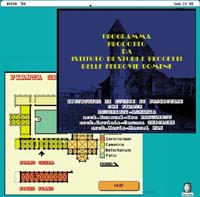
By clicking on the word "general catalog", a dialog box will appear for opening the applications, on which the names of the StereoFot documents, the "MoviePlayer" or "MacroMind Director" movies will be displayed as well as the documents compiled with " SuperCard ". Selecting any application always leaves the main StereoFot window open; therefore, the RAM memory of the computer used must not be less than the total memory required by the System plus the sum of those assigned to the individual open applications. In the image of this page there are two "cards" of the work carried out, at the S. Scolastica laboratory, by the Romanian architects Emanuel Radulescu, Carmen Laviniae and Has Horia Marcel, who participated in 1992 in the intensive course of Architectural photogrammetry for the documentation of sacred architecture. As for the films, provided that the StereoFot ones are contained in the "movies" folder, the "dialog" that opens with the "general catalog" selection allows you to view any movie recorded with MoviePlayer. In addition to the video window and an inscription indicating the name and duration of the video, a palette appears containing a series of buttons that allow you to:
- pause the movie;
- call up the dialog for opening another movie;
- bring the movie back to the first frame;
- show, in a "clipboard" window, a PICT containing a frame (by closing the window or recalling another frame a "dialog" appears allowing the recording of the image);
- advance the movie (in both directions) quickly or by single frame;
- make the button to call up the control bar of the video itself visible in the video window (this controls both the sound volume and the "slow motion");
- call up or hide the movie control bar; close the video window;
- store the position of a frame (by selecting this button a scrolling field appears in which the data is stored, on which it is
- can click to return to the corresponding frame).
To get an idea of "digital" publishing, just think of any research done in a library or video library and eliminate all "downtime". Go to the library; access the catalog; make the volume request; take notes or request some photocopies; return it; request another volume; exit the library; go to the video library and repeat all the operations related to the consultation; go to a foreign library: they are all operations (including the overcoming of Italian borders) which are replaced by a simple "click". When these words were repeated in a "university assembly" an "illustrious teacher" has ironized: "what a sad future awaits us, sitting in front of a monitor!". In order not to challenge the usual "weapon" of the controversy, I simply replied: "but in order not to be sad, you can always resort to traditional methods!". Sure! those methods that have managed to train thousands of "cheerful" and ... unemployed technicians!
This page shows the "StereoFot Help" stack : a sort of "open aid". With a click on the chosen topic, you go to the sheet containing the relative explanations. But who has ever been satisfied with the explanations provided by a text, even if they seem very clear as soon as they are read? The advantage of this "instruction booklet" is given by the ease with which it can be modified and customized! If any answer does not satisfy us and we have some time, we can move, with a few "clicks", to an Italian or Eastern library